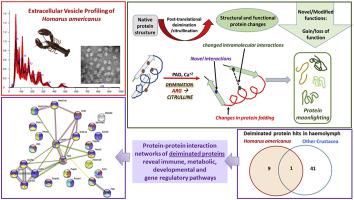Fish & Shellfish Immunology ( IF 4.7 ) Pub Date : 2020-07-28 , DOI: 10.1016/j.fsi.2020.06.053 Timothy J Bowden 1 , Igor Kraev 2 , Sigrun Lange 3

|
The American lobster (Homarus americanus) is a commercially important crustacean with an unusual long life span up to 100 years and a comparative animal model of longevity. Therefore, research into its immune system and physiology is of considerable importance both for industry and comparative immunology studies. Peptidylarginine deiminases (PADs) are a phylogenetically conserved enzyme family that catalyses post-translational protein deimination via the conversion of arginine to citrulline. This can lead to structural and functional protein changes, sometimes contributing to protein moonlighting, in health and disease. PADs also regulate the cellular release of extracellular vesicles (EVs), which is an important part of cellular communication, both in normal physiology and in immune responses. Hitherto, studies on EVs in Crustacea are limited and neither PADs nor associated protein deimination have been studied in a Crustacean species. The current study assessed EV and deimination signatures in haemolymph of the American lobster. Lobster EVs were found to be a poly-dispersed population in the 10–500 nm size range, with the majority of smaller EVs, which fell within 22–115 nm. In lobster haemolymph, 9 key immune and metabolic proteins were identified to be post-translationally deiminated, while further 41 deiminated protein hits were identified when searching against a Crustacean database. KEGG (Kyoto encyclopedia of genes and genomes) and GO (gene ontology) enrichment analysis of these deiminated proteins revealed KEGG and GO pathways relating to a number of immune, including anti-pathogenic (viral, bacterial, fungal) and host-pathogen interactions, as well as metabolic pathways, regulation of vesicle and exosome release, mitochondrial function, ATP generation, gene regulation, telomerase homeostasis and developmental processes. The characterisation of EVs, and post-translational deimination signatures, reported in lobster in the current study, and the first time in Crustacea, provides insights into protein moonlighting functions of both species-specific and phylogenetically conserved proteins and EV-mediated communication in this long-lived crustacean. The current study furthermore lays foundation for novel biomarker discovery for lobster aquaculture.
中文翻译:

美国龙虾(Homarus americanus)的血淋巴中的细胞外囊泡和翻译后蛋白质决定标记。
美国龙虾(龙虾美洲)是具有重要商业意义的甲壳动物,具有长达100年的异常长寿命和长寿的比较动物模型。因此,对其免疫系统和生理学的研究对于工业和比较免疫学研究都具有相当重要的意义。肽基精氨酸脱亚氨酶(PADs)是系统发育上保守的酶家族,其通过精氨酸向瓜氨酸的转化催化翻译后蛋白的脱氨。这可能导致蛋白质的结构和功能改变,有时在健康和疾病中助长蛋白质月光。PADs还调节细胞外囊泡(EVs)的细胞释放,这在正常生理和免疫应答中都是细胞通讯的重要组成部分。到目前为止,在甲壳动物中对电动汽车的研究是有限的,在甲壳动物中既没有研究PADs也没有研究相关的蛋白质脱氨作用。当前的研究评估了美国龙虾血淋巴中的EV和决定标记。发现龙虾电动车是10-500 nm尺寸范围内的多分散种群,大多数较小的电动车都在22-115 nm范围内。在龙虾血淋巴中,在甲壳动物数据库中搜索时,鉴定出9个主要的免疫和代谢蛋白被翻译后修饰,同时还鉴定了41个修饰的蛋白命中。KEGG(基因和基因组京都百科全书)和GO(基因本体论)富集的这些决定蛋白的分析表明,KEGG和GO途径与许多免疫有关,包括抗病原性(病毒,细菌,真菌和宿主-病原体的相互作用,以及代谢途径,水泡和外泌体释放的调节,线粒体功能,ATP生成,基因调节,端粒酶稳态和发育过程。在本研究中,在龙虾中,首次在甲壳动物中报道了电动汽车的特征和翻译后的修饰特征,这为人们提供了深入了解物种特异性和系统发育保守的蛋白质的蛋白质月光功能以及电动汽车介导的交流的方法。甲壳动物。本研究进一步为龙虾水产养殖的新型生物标志物发现奠定了基础。在本研究中,在龙虾中,首次在甲壳动物中报道了电动汽车的特征和翻译后的修饰特征,这为人们提供了深入了解物种特异性和系统发育保守的蛋白质的蛋白质月光功能以及电动汽车介导的交流的方法。甲壳动物。本研究进一步为龙虾水产养殖的新型生物标志物发现奠定了基础。在本研究中,在龙虾中,首次在甲壳动物中报道了电动汽车的特征和翻译后的修饰特征,这为人们提供了深入了解物种特异性和系统发育保守的蛋白质的蛋白质月光功能以及电动汽车介导的交流的方法。甲壳动物。本研究进一步为龙虾水产养殖的新型生物标志物发现奠定了基础。



























 京公网安备 11010802027423号
京公网安备 11010802027423号